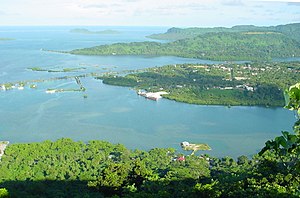 | |
| Currency | United States dollar |
|---|---|
| 1 October- 30 September | |
| Statistics | |
| GDP | |
| GDP rank | 186th nominal (2013) |
GDP growth |
|
GDP per capita | |
GDP by sector | Agriculture: 26.3% Industry: 18.9% Services: 54.8% (2017 est.)[2] |
| 1.5% (2018)[1] | |
Population below poverty line | 26.7% (2000)[3] |
| 40.1 (2013)[4] | |
Labor force | 37,920 (2010)[5] |
Labor force by occupation | services: 93.9% agriculture: 5.2% industry: 0.9% (2013 est.)[6] |
| Unemployment | 16.2% (2010)[7] |
| External | |
| Exports | $39.88 Million (2015 est.)[8] |
| Imports | $167.8 Million (2015 est.)[9] |
FDI stock | $15.8 Million (2013 est.)[10] |
| Public finances | |
| 24.5% of GDP (2017 est.)[11] | |
| Revenues | $213.8 Million (2013 est.)[12] |
| Expenses | $192.1 Million (2013 est.)[13] |
| $157 Million (2016)[14] | |
All values, unless otherwise stated, are in US dollars. | |
The economic activity of the Federated States of Micronesia consists primarily of subsistence agriculture and fishing. The islands have few mineral deposits worth exploiting, except for high-grade phosphate. The potential for a tourist industry exists, but the remoteness of the location and a lack of adequate facilities hinder development. Financial assistance from the US is the primary source of revenue, with the US pledged to spend $1.3 billion in the islands in 1986–2001. Geographical isolation and a poorly developed infrastructure are major impediments to long-term growth.
Under the terms of the Compact of Free Association, the United States provided FSM with around $2 billion in grants and services from 1986 to 2001. The Compact's financial terms are being renegotiated for an extension period. In 2001 the U.S. provided more than $84 million in Compact grants—an amount equivalent to over one-third of FSM's GDP—plus more than $20 million through other federal programs. Total official development assistance from all sources was more than $100 million in 2001, with nearly 90% of that total coming from the U.S.
The FSM public sector plays a central role in the economy as the administrator of the Compact money. The national and state-level governments employ over one-half of the country's workers and provide services accounting for more than 40% of GDP. Faced with the potential decrease or cessation of some of the assistance programs upon the Compact's financial provisions' expiry in 2001, the Government of the FSM in 1996 began to implement a program of economic reforms designed to reduce the role of the public sector in the economy. In addition, the advent of music startups using .fm domain names has provided a new, albeit fairly small, stream of revenue to the government.[15]
- ^ a b c d e f "World Economic Outlook Database, October 2019". International Monetary Fund. Retrieved 20 October 2019.
- ^ "The World Factbook". 6 December 2023.
- ^ "The World Factbook". 6 December 2023.
- ^ "Gini index (World Bank estimate) | Data".
- ^ "The World Factbook". 6 December 2023.
- ^ "The World Factbook". 6 December 2023.
- ^ "The World Factbook". 6 December 2023.
- ^ "The World Factbook". 6 December 2023.
- ^ "The World Factbook". 6 December 2023.
- ^ "The World Factbook". 6 December 2023.
- ^ "The World Factbook". 6 December 2023.
- ^ "The World Factbook". 6 December 2023.
- ^ "The World Factbook". 6 December 2023.
- ^ "The World Factbook". 6 December 2023.
- ^ Hezel, Francis X. (2012). "Pacific Island Nations: How Viable Are Their Economies?". Pacific Islands Policy. 7: 15. hdl:10125/22221. Retrieved 1 September 2022.